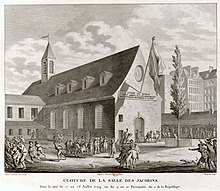
Back رد فعل ترميدورين Arabic احداث ثيرميدور ARZ Reacció Termidoriana Catalan Θερμιδοριανή Αντίδραση Greek Reacción de Termidor Spanish Berolisko Konbentzioa Basque واکنش ترمیدوری Persian Convention thermidorienne French הריאקציה התרמידורית HE A thermidori reakció Hungarian

In the historiography of the French Revolution, the Thermidorian Reaction (French: Réaction thermidorienne or Convention thermidorienne, "Thermidorian Convention") is the common term for the period between the ousting of Maximilien Robespierre on 9 Thermidor II, or 27 July 1794, and the inauguration of the French Directory on 2 November 1795.
The "Thermidorian Reaction" was named after the month in which the coup took place and was the latter part of the National Convention's rule of France. It was marked by the end of the Reign of Terror, decentralization of executive powers from the Committee of Public Safety and a turn from the radical Jacobin policies of the Montagnard Convention to more moderate positions.
Economic and general populism, dechristianization, and harsh wartime measures were largely abandoned, as the members of the convention, disillusioned and frightened of the centralized government of the Terror, preferred a more stable political order that would have the approval of the plurality. The Reaction saw the Left suppressed by brutal force, including massacres, as well as the disbanding of the Jacobin Club, the dispersal of the sans-culottes, and the renunciation of the Montagnard ideology.